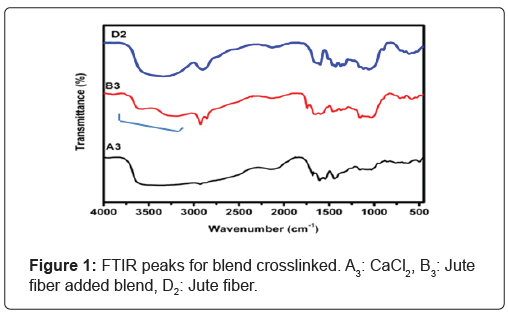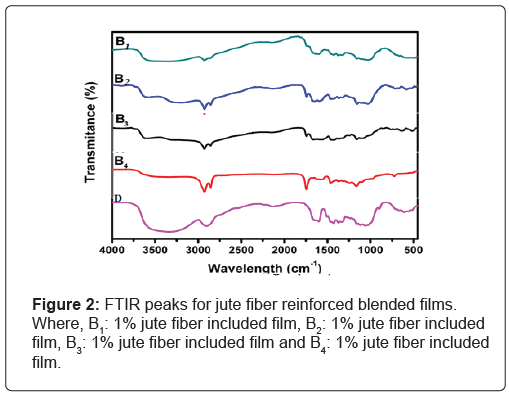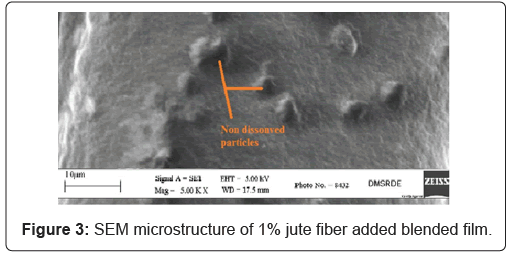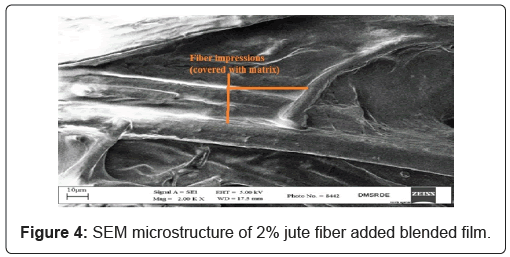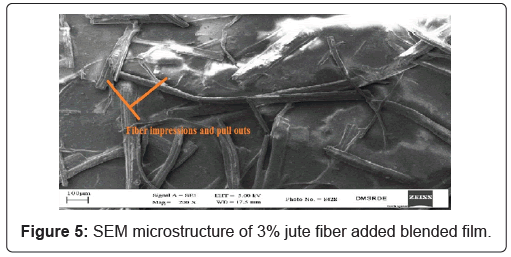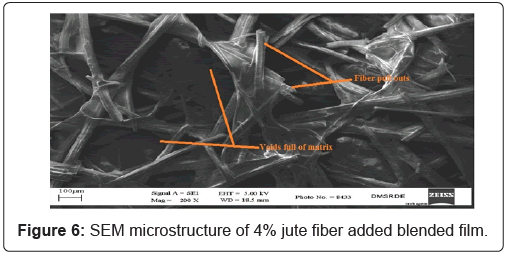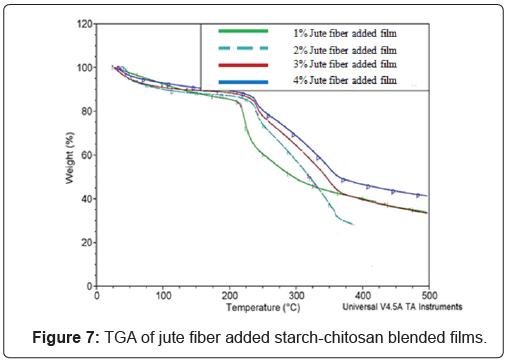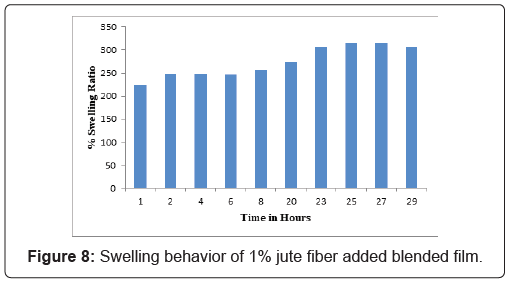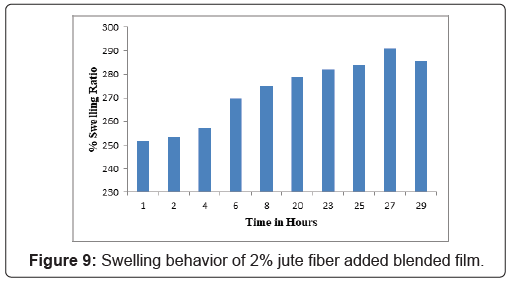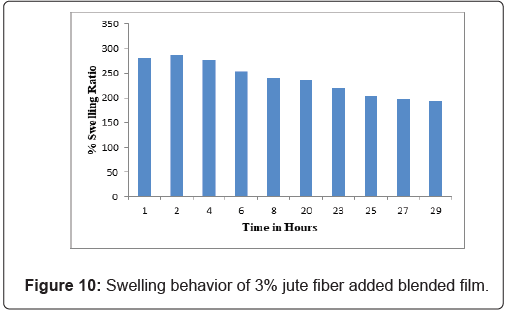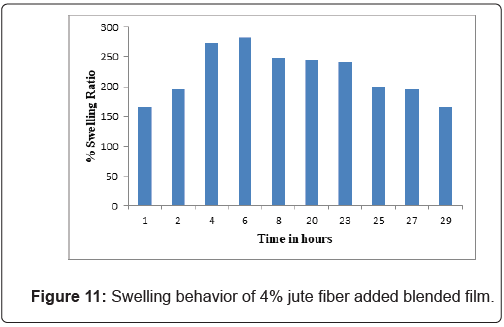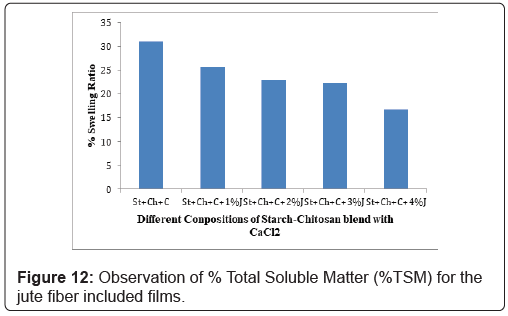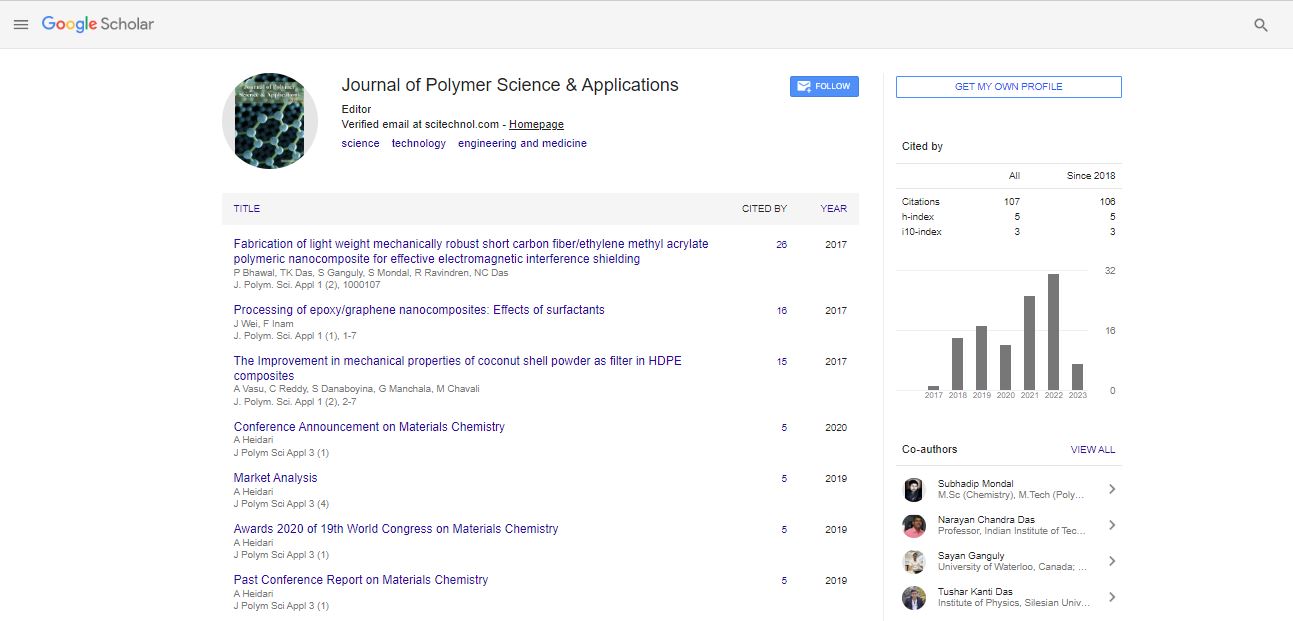Research Article, J Polym Sci Appl Vol: 4 Issue: 5
Jute Fiber Added Starch Chitosan Blended Films Crosslinked with CaCl2
Neena Singh and Jaya Maitra*Department of Applied Chemistry, School of Vocational Studies and Applied Sciences, Gautam Buddha University, Greater Noida, India
*Corresponding Author : Jaya Maitra
Department of Applied chemistry, School of Vocational Studies and Applied Science, Gautam Buddha University, Greater Noida, India
E-mail: jaya@gbu.ac.in
Received: November 6, 2020 Accepted: November 20, 2020 Published: November 27, 2020
Citation: Maitra J, Singh N (2020) Jute Fiber Added Starch-Chitosan Blended Films Crosslinked with CaCl 2. J Polym Sci Appl 2020 4:5.
Keywords: Starch; Chitosan; Blend; Cross-linking; Solubility behavior; Jute fiber
Introduction
Intrinsic properties of natural fibers make them the preferred material to strengthen the blended films. Addition of natural fiber to the blended films facilitates production of low weight blended films. Properties such as low cost, low density per unit volume, adequate specific strength with reduced tool wear, biodegradability and non- abrasiveness are the significant characteristics for the consideration of natural fibers [1]. The chemical composition of natural fibers are also quite interesting; basically it depends on the geographic origin, climatic conditions, harvesting process, fiber extraction process and finally the storage or transportation conditions.
The natural fibers such as jute, hemp, rice husk, abaca wheat straw, coir, kenaf, flax etc are common reinforcing natural fibers [2]. These natural fibers are also known as agro-fibers. They are biodegradable and do not produce any ecological imbalance. The present research is based on the development of starch-chitosan blended films crosslinked with calcium chloride with the addition of jute fiber. Jute fiber is one of the most under-utilized agricultural raw materials. The ease of availability, renewable nature, admirable mechanical properties, low cost and low energy consumption for processing of jute fiber makes it an ideal material of choice amongst scientists. The annual production of jute primarily in South Asia is around 3,000,000 tons/ year [3,4]. Agro-fiber jute is a lingo-cellulosic natural fiber. Cellulose, hemicellulose and lignin are the main components of lingo-cellulosic natural fibers. They also contain pectin, waxes and water soluble substances [5].
Due to the hydrophilic nature of natural fibers, the poor interfacial interaction between the natural fiber and the polymer matrix reduces the potential of natural fiber as reinforcing agent. Therefore the chemical modifications are required to improve the interfacial interaction of natural fibers and polymer matrix either by activating the hydroxyl group or by introducing the new moieties for efficient interlocking of natural fiber and polymer matrix. In present research jute fibers are chemically treated to improve the surface of the fibers. Chemical treatment of fiber increases the fiber strength and adhesion between polymer matrix and surface of the fiber. Chemical treatment of fiber reduced the water absorption capacity and increased the mechanical properties of the fiber. Amongst all existing chemical treatments, alkali treatment is a well establish chemical treatment which removes lignin, oil and wax from the exterior layer of the fiber cell and also decomposes cellulose into small segments [6]. During alkali treatment hydroxyl group of aqueous sodium hydroxide (NaOH-OH) ionized fiber to alkoxide and increase the roughness of the surface to provide good mechanical properties which also affects the strength and stiffness of the fiber [6].
Fiber + 2NaOH-OH → Fiber–Na-O + H2O
Starch-chitosan blended films crosslinked with calcium chloride are highly soluble and the present study emphasises the inclusion of jute fiber in the starch-chitosan blended film decreasing the solubility of the film. The solubility (percentages) of jute added blended films are measured by measuring the percent Total Soluble Matter (%TSM) of the jure fiber added blended films and concurrently the swelling behavior of the blended films is also observed. The jute fiber added blended films are characterized by Fourier Transform Infrared Spectroscopy (FTIR), Scanning Electron Microscope (SEM) and Thermogravimetric Analysis (TGA).
Experiments
Polymers and reagents
Calcium chloride from Himedia, Chitosan from Himedia, Glacial acetic acid from Himedia, Glutaraldehyde from Himedia, Starch- extra pure from Titan Biotech Ltd., Parafilm “M” from Pechiney Plastic Packaging Chicago. Sodium-Hydroxide from Central Drug House Private Ltd., Jute fabric is gifted by Mechanical Laboratory, Gautam Buddha University, Greater Noida (U.P.)
Treatment of jute fiber
Jute fabric is cut into the pieces and dipped in 6% NaOH solution for 72 hours. Then it is washed several times under normal running water followed by 12 to 15 times with distilled water. Having dried the fiber pieces at 150°C in oven for 6 to 7 hours, it is grinded in mixer and sieved with 60 BSS sieve.
Preparation of chitosan-starch blend (crosslinked with calcium-chloride)
100 ml of 2% (w/v) starch aqueous solution is added to 100 ml of 2% (w/v) chitosan solution (in 1% acetic acid) with continuous stirring at 600 rpm and then 20 ml of 2% (w/v) calcium-chloride solution is added drop by drop into the resulting mixture. The mixture is finally subjected to stirrer for 24 hours at 500 rpm post which it is ready for experimentation.
Preparation of jute added starch-chitosan blended films
The resulting blend weighing 100 g is added with 1 g, 2 g, 3 g and 4 g sieved fiber and then placed under continuous stirring for at least 24 hours. After that, the blends are poured in the petri-plates and kept at room temperature for drying. After drying, thin films are peeled off from the petri-plates and are placed in hot air oven at 25°C-30°C for 15 minutes. Having done the thin films are stored in plastic poly bags.
Swelling property of jute fiber added starch-chitosan blended film
The percent swelling ratios of the jute fiber added films are measured to observe the swelling behavior of the films. The known weight (Wd) of each film is immersed in distil water at room temperature for thirty hours. Consequently, every after 1-2 hrs added films are removed from the distil water and is weighed (Ws) to observe the swelling behavior of the jute fiber added films and the percentage swelling ratios are measured by the equation:
E=[(Ws–Wd)/Wd] × 100.
Where E=percent swelling ratio
Wd=Weight of sample in dry state.
Ws=Weight of sample in swollen state.
Preparation of jute solubility of jute fiber added blended films (%Total Soluble Matter)
Jute fiber added films are cut into 1 × 1 cm. Pieces and afterwards weighed, and immersed in 10 ml distil water for 24 hours. After 24 hours, pieces are removed from the distil water and dried in the hot air oven at bekar hai chemistry 30°C for 5 to 6 hours to determine the final dry weight of added films. Solubility of fiber added blended films is measured by the following equation [7,8].
%TSM=[(Initial Dry Weight–Final Dry Weight)/Initial Dry Weight] × 100
Where, %TSM=Total soluble matter of the blended films.
Characterization of jute fiber added starch-chitosan blend
The surface morphology of the jute fiber added starch-chitosan blended films is observed by the microstructures obtain from the Scanning Electron Microscopy (SEM). Prepared films are also characterized by Fourier Transform Infrared Spectroscopy (FTIR) and Thermogravimetric analysis (TGA).
Fourier Transform Infrared (FTIR) studies
FT-IR analyses of jute fiber added starch-chitosan blended films crosslinked with CaCl2 is measured in the wavenumber range 500– 4000 cm−1 (Figure 1).
FTIR spectrum of pure chitosan (A1) shows the broad band in the range from 3744 cm-1 to 3000 cm-1, due to stretching vibrations of OH groups which are overlapped to the stretching vibration of N-H in the range of 3500-3000 cm-1 , C–H stretching in –CH2 and –CH3 at 2920 cm-1 and 2875 cm-1 , respectively [9,10]. Further the visible peaks at 1375 cm-1 and 1426 cm-1 confirm the presence of CH2 groups (due to bending vibrations of methylene and methyl group) [11]. FTIR spectrum of jute fiber (D2) shows the broad band in the range from 3700-3000 cm-1 [VOH], due to stretching vibrations of OH groups [12]. The spectra also demonstrate the peak at 2883 cm-1 for symmetrical C–H stretching and peak at 1724 cm-1 recognized for C=O stretching. O-CH bending in plane is observed at 1423 cm-1 while peak at 1368 cm-1 and 1363 cm-1 demonstrate the C-H bending in plane. S-lignin ring stretching is also observed at 1325 cm-1 while G-lignin ring stretching is observed at 1259 cm-1. Peak at 1314 cm-1 demonstrate the CH2 rocking vibration at C6 position. Peak at 1245 cm-1 attributed to C-C, C-O and C=O stretching and peak at 1232 cm-1 recognized for C-OH bending at C6 position.
FTIR spectrum of jute fiber added starch-chitosan blend (B3) shows the reduced peak intensity between the range 3700-3000 cm-1 due to the O-H stretching, it predict the interaction of jute fiber with polymer matrix. The results of FTIR also demonstrate the O-H stretching peak between the range 3700-3000 cm-1 reduces as the increase of jute fiber ratio in the film (Figure 2).
The other spectral peaks in Figure 2 demonstrate the elevated intensity of C-H stretching at 2883 cm-1 and C=O stretching at 1724 cm-1 as the jute fiber ratio increase in the films which further proves the interaction of jute fiber and polymer matrix. The other evidence of ionic interaction between the jute fiber and polymer matrix is the reduced intensity of peaks between the range 1370 cm-1 to 1330 cm- 1(C-H bending in-the-plane) which further proves that the addition jute fiber provide the strength to the film.
Scanning Electron Microscopy (SEM)
The Scanning Electron Microscopy (SEM) of jute fiber added starch and chitosan blended films is analyzed by Carl Zeiss EVO-50.
SEM microstructures demonstrate the inhomogeneous mixture of fiber and polymer matrix for jute fiber added blended films. Microstructure observations also illustrate the surface roughness of the blended films increases as the fiber ratio increase in the blended films (Figure 3).
Microstructures explain the presence of non dissolved particles on the surface of blended films as shown in Figure 3 (1% jute fiber added blended films). Microstructure also illustrates the proper adhesion/ covering of polymer matrix on the jute fiber (Figure 4). Increase of fiber ratio in the blended films, emerges the fiber impression on the surface of the blended films. Impressions turns to the fiber pull outs, on increase the fiber ratio in the blended films (Figures 4-6). The impressions or fiber pull outs both exemplify the full covering of fiber with the polymer matrix. The covering of fiber with the polymer matrix signifies the good adhesion of fiber and polymer matrix which supports the mechanical strength of the films. Figures 4-6 explain the impressions changes to the pullouts and create the voids on the surface of the film. The voids are filled with polymer matrix. Figures 5 and 6 clarify the emergence of the void on the surface of films.
Thermogravimetric Analysis (TGA) of jute fiber added starch- chitosan blended film
TGA thermograms of jute fiber added starch-chitosan blended films crosslinked with calciumchloride (in the temperature range 0°C to 500°C under nitrogen) is shown in Figure 7.
Thermal details (TGA) of jute fiber added chitosan-starch blended films crosslinked with CaCl2 are shown in Table 1 and Figure 7. Table 1 shows as the fiber ratio increase in the films, the degradation occurs at higher temperature which further demonstrates the addition of fiber provide the mechanical strength to the films. Figure 7 shows the two consecutive weight loss steps for jute fiber added chitosan-starch blended films. First weight loss occurs after 14% decomposition at 180°C for 1% jute added film while for 2%, 3% and 4% jute added films first weight loss occurs after 12% decomposition at 200°C, 220°C and 225°C respectively. Second weight loss occurs after 58% decomposition at 370°C for 1% jute added film, after 72% decomposition at 382°C for 2% jute added film, after 60% decomposition at 400°C for 3% jute added film and after 55% decomposition at 407°C for 4% jute added film.
| Percentage decomposition (%) | Decomposition temperature (°C) | |||
|---|---|---|---|---|
| 1% jute added film | 2% jute added film | 3% jute added film | 4% jute added film | |
| 10 | 130°C | 108°C | 145°C | 180°C |
| 20 | 225°C | 245°C | 251°C | 258°C |
| 30 | 230°C | 263°C | 280°C | 300°C |
| 40 | 253°C | 295°C | 320°C | 337°C |
| 50 | 297°C | 325°C | 350°C | 375°C |
| 60 | 400°C | 350°C | 400°C | ______ |
Table 1: TGA Thermal studies of jute fiber added chitosan-starch films.
Decomposition of cellulose (jute fiber constituent) starts in the range of 160°C-210°C and the decomposition of cellulose constituent include depolymerization, thermoxidation, dehydration, and formation of glycosans [13] while decomposition of lignin starts below the temperature 220°C–250°C and it includes condensation and splitting of the side chains, formation of free radicals during active pyrolysis and a series of degradation and condensation reactions with accretion of aromatic products. Hemicellulose constituent of jute fiber decompose in the range of 159°C–280°C [11].
Results and Discussion
Swelling behavior of the jute fiber added blended films
The swelling of the samples after the particular interval (every after one or two hour) of the time is given in the Table 2 while the calculated percentage swelling ratio is given in Table 3 and the graphs from Figures 8-11 shows the calculated percentage swelling ratio of each sample.
| Jute fiber added films | Dry weight (g) | Wet Weight (g) | |||||||||
|---|---|---|---|---|---|---|---|---|---|---|---|
| am | pm | am | pm | ||||||||
| 11:30 | 12:30 | 01:30 | 03:30 | 05:30 | 07:30 | 07:30 | 10:30 | 12:32 | 02:30 | 04:30 | |
| 1% | 0.041 | 0.133 | 0.143 | 0.014 | 0.143 | 0.146 | 0.153 | 0.167 | 0.17 | 0.17 | 0.167 |
| 2% | 0.056 | 0.197 | 0.198. | 0.2 | 0.207 | 0.21 | 0.212 | 0.214 | 0.215 | 0.219 | 0.216 |
| 3% | 0.03 | 0.114 | 0.116 | 0.113 | 0.106 | 0.102 | 0.101 | 0.096 | 0.091 | 0.089 | 0.088 |
| 4% | 0.029 | 0.077 | 0.086 | 0.108 | 0.111 | 0.101 | 0.1 | 0.099 | 0.087 | 0.086 | 0.077 |
Table 2: Swelling behavior of the jute fiber added blended films.
| Jute fiber added films | After one hour | After two hours | After four hours | After six hours | After eight hours | After Twenty hours | After Twenty three hours | After Twenty five hours | After Twenty seven hours | After Twenty nine hours |
|---|---|---|---|---|---|---|---|---|---|---|
| 1% | 224.39 | 248.78 | 248.78 | 246.34 | 256.09 | 273.17 | 307.31 | 314.63 | 314.63 | 307.31 |
| 2% | 251.78 | 253.57 | 257.14 | 269.64 | 275 | 278.57 | 282.14 | 283.92 | 291.07 | 285.71 |
| 3% | 280 | 286.66 | 276.66 | 253.33 | 240 | 236.66 | 220 | 203.33 | 196.66 | 193.33 |
| 4% | 165.51 | 196.55 | 272.41 | 282.75 | 248.27 | 244.82 | 241.37 | 200 | 196.55 | 165.51 |
Table 3: % Swelling ratio of the jute fiber added blended films.
Figure 8 and 9 depicts, 1% and 2% jute fiber added films maximum swells after two hours i.e. 248.78% and 283.92% respectively and then the swelling weight for 1% and 2% jute blended films get stable for next few hours. After that the swelling behavior further increases. 1% jute fiber added films achieve the maximum swelling weight at 25th hour i.e. 314.63% and then it further become stable for next two hours while 2% jute added film achieve the maximum swelling weight at 27th hour i.e. 291.07% after that it shows the decline of swelling weight (Figures 9-11). shows the 3% and 4% jute fiber added films swells maximum after two and six hours respectively (i.e. 286.66% and 282.75% respectively). After that the swelling weight of 3% and 4% jute fiber added film decreases continuously.
Results also demonstrated that the percent swelling ratio decreases as the fiber ratio increase in the blend. For the reason, the bonding/ interaction between the polymer matrix and jute fiber increases/ enhances and the availability of the non-bonded matrix decreases to swell, as the fiber ratio increase in the film. The results are supported by FTIR, SEM and TGA. Results are also supported by the percent Total Soluble Matter (solubility) interpretation of the films (Table 4).
| S.N. | Samples | Initial Dry Weight of jute added films (g) | Final Dry Weight of jute added films (g) | %Total Soluble Matter (%TSM) |
|---|---|---|---|---|
| 1 | St+Ch+C | 0.026 | 0.0179 | 31.15 |
| 2 | St+Ch+C+1%J | 0.0132 | 0.0098 | 25.75 |
| 3 | St+Ch+C+2%J | 0.0156 | 0.012 | 23.07 |
| 4 | St+Ch+C+3%J | 0.0197 | 0.0153 | 22.33 |
| 5 | St+Ch+C+4%J | 0.0274 | 0.0228 | 16.78 |
Table 4: Measured percentage total soluble matter for the blended films.
Solubility of jute fiber added blended films (%Total Soluble Matter)
To observe the solubility of the films the percentage of Total Solubility Matter (%TSM) for the films is measured. Measured percentage of Total Solubility Matter for starch-chitosan blended films cross-linked with CaCl2 is 31.15% which is quite high and shows that the films are highly soluble but, %TSM declines as the 1% jute fiber is added to the film i.e. 25.75% (as shown in Figure 12). After that the percentage of Total Solubility Matter of jute fiber added blended films declines as the fiber ratio increase in the blend i.e. the %TSM for 2%, 3%, 4% jute fiber added film is 23.07%, 22.33% and 16.78% respectively. The percentage of Total Solubility Matter (%TSM) declines from 25.75% to 16.78% as the ratio of jute fiber increased in the jute fiber added blended films. The solubility test of blended films predicts that the acquaintance of the film contents improves as the jute fiber ratio increase in the blended films.
Conclusion
Present work focuses on the development of natural, eco-friendly; inexpensive fiber (jute) added starch and chitosan blended films. Chitosan blended with starch provide the antibacterial property and strength to the blended films and low cost, biodegradable, renewable, and easily available jute fibers proclaims it as a promising reinforcing material for starch-chitosan blended films. Small size (sieved 60) of jute fiber helps for almost equal distribution of fiber throughout the blend.
Experimental observation indicates that the availability of polymer matrix is higher in 1% jute fiber added film that can absorb the great amount of water and can show the highest swelling behavior. Results also revealed that the inclusion of jute fiber hold the matrix (form the bonds with the matrix) hence it decrease the solubility as the increase of jute fiber ratio in the films. The results of FTIR, SEM and TGA studies also prove the intermolecular interaction between the polymer matrix and jute fiber which in turn influences the properties of films, like solubility behavior, percentage Total Solubility Matter.
References
- Saba N, Tahir P Md, Jawaid M (2014) A review on potentiality of nano filler/natural fiber filled polymer hybrid composites. Polymers 6: 2247-2273.
- Khan N Md, Roy JK, Akter N, Zaman HU, Islam TT, et al. (2012) Production and properties of short jute and short E-glass fiber reinforced polypropylene-based composites. Open J Compos Mater 2: 40-47.
- Satyanarayana KG, Arizaga GG C, Wypych F (2009) Biodegradable composites based on lignocellulosic fibers: An overview. Prog Polym Sci 34: 982–1021.
- Thomasa MG, Abrahamb E, Jyotish kumara P, Maria HJ, Pothenb LA, et al. (2015) Nano celluloses from jute fibers and their nano composites with natural rubber: Preparation and characterization. Int J Biol Macromol 81: 768–777.
- Verma D, Gope PC, Shandilya A, Gupta A, Maheshwari MK (2013) Coir fibre reinforcement and application in polymer composites: A review. J Mater Environ Sci 4: 263-276.
- Priya NAS, Raju PV, Naveen PNE (2014) Experimental testing of polymer reinforced with coconut coir fiber composites. Int J Emerging Technol Adv Eng 4: 453-460.
- Sothornvit R, Krochta JM (2000) Water vapor permeability and solubility of films from hydrolyzed whey protein. J Food Sci 65: 700-703.
- Motedayen AA, Khodaiyan F and Salehi EA (2013) Development and characterisation of composite films made of kefiran and starch. Food Chem 136: 1231–1238.
- Marchessault RH, Ravenelle F, Zhu XX (2006) Polysaccharides for drug delivery and pharmaceutical applications. Washington: American Chemical Society 934: 243-259.
- Silva SML, Braga CRC, Fook MVL, Raposo CMO, Carvalho LH (2012) Application of infrared spectroscopy to analysis of chitosan/clay nanocomposites. Infrared spectroscopy-materials science, engineering and technology Edtec pp: 41-62.
- Mano JF, Koniarova D, Reis RL (2003) Thermal properties of thermoplastic starch synthetic polymer blends with potential biomedical applicability. J Mater Sci Mater Med 14: 127-135.
- Fan M, Dail D, Huang B (2012) Fourier Transform Infrared Spectroscopy for Natural Fibres. Fourier Transform – Materials Analysis Ed In Tech pp: 45-68.
- Monteiro SN, Calado V, Rodriguez RJS, Margem FM (2012) Thermogravimetricstability of polymer composites reinforced with less common lignocellulosic fibers: An overview. J Mater Res Technol 1: 117–126.
 Spanish
Spanish  Chinese
Chinese  Russian
Russian  German
German  French
French  Japanese
Japanese  Portuguese
Portuguese  Hindi
Hindi 